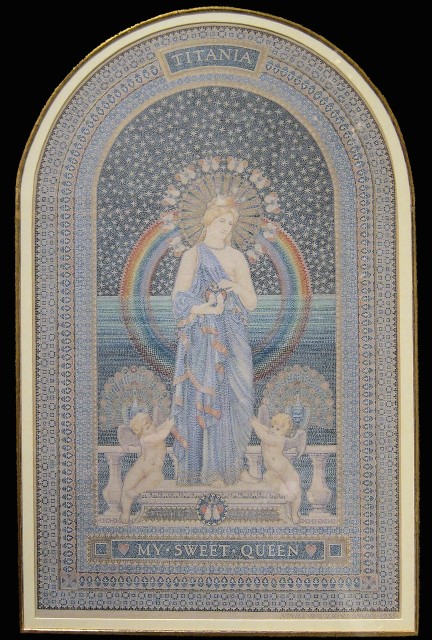The beautiful artwork presented this week is a highly complex and detailed painting. The work measures 15 x 9 ¼ inches and it reportedly took the artist, Major Sir Nevile Wilkinson, one day to paint one square inch. Painted in watercolour and gold leaf the work is a design for a mosaic, much like those he designed and made to be included in his numerous dollhouse projects. These beautifully detailed, highly decorated and often enormous dollhouses will be discussed later in this post. First, however, let us look to the artist.
The Artist:
Major Sir Nevile Wilkinson KCVO was a British officer of arms, British Army officer, author, architect, artist and, as already mentioned, a dolls house designer.
He served in the military and was commission into the Coldstream Guards in 1890 and served in the Second Boer War. He retired in 1907, although he returned to service in the First World War as a staff officer and was promoted to Major in 1915.
He was Principal Officer of Arms of Ireland from 1908, and one of the chief heraldic officers in the United Kingdom.
He was appointed Commander of the Royal Victorian Order (CVO) after the visit of the King to Dublin in 1911, knighted in the 1920 New Year Honours, and appointed Knight Commander of the Royal Victorian Order (KCVO) after the state opening of the Parliament of Northern Ireland in June 1921.
Wilkinson was exhibited at the Royal Academy on seventeen occasions from 1927 to the year of his death in 1940. His unique designs for mosaics, like the example shown here, were displayed no less than eight times during that period.
The Dollhouses:
Wilkinson built two famous dollhouses, Titania's Palace (completed and inaugurated in 1922 by Queen Mary) and Pembroke Palace (completed in 1907). Titania's Palace remained in the family for many years, but was sold after 1960 first to an English amusement park and then to Legoland in Denmark. Pembroke Palace Dolls House is now at Wilton House, seat and home of the 18th Earl of Pembroke.
Titania’s Palace is 116" long, 19" wide and the main bulk is 30" high. The dome and cupola over the chapel add another 65" to its height. The walls are ornamental in bronze, its windows fitted with stained glass.
The palace included seventeen different rooms including the Hall of Guards, The Hall of the Fairy Kiss, The chapel, Oberon’s Study, Titania’s Boudoir and The Throne Room. All decorated to the highest of standards, with original works of art, mosaics, working instruments house hold items often made from precious metals and adorned with gems.
Wilkinson intended the palace to travel all over the world and the eight sections were light enough to be easily moved and lowered into padded packing cases without danger and transported on a 4 tonne lorry. The house travelled to 160 cities in the British Isles before going on to North and South America, New Zealand, Canada, The Netherlands, Australia and of course Dublin and Ballynastragh, Gorey, Co. Wexford.
Sir Nevile had attended the Royal College of Art in South Kensington, London and had developed an interest in miniature decorative painting which involved a technique which he called "mosaic painting" using an etchers glass. He stippled minute dabs of watercolour all irregularly shaped like mosaic and numbering 1,000 or more per square inch. The result was ideally suited to the decoration of Titania's Palace and his miniature mosaics decorate many of the rooms.
The Painting:
The “mosaic painting” technique and Wilkinson’s precise attention to detail is beautifully shown in the work presented here. He also employs a beautiful balance of design and a vibrant colour scheme, which come together to form a very pleasurable piece.
Please do get in touch should you wish to find out more about the painting and, as ever, check back here regularly for up-to-date information, new painting acquisitions and exhibition news.
Julian and Michael Brookstone

